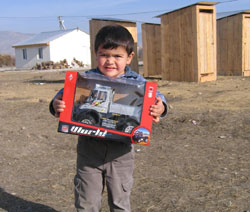Since the European Union Monitoring Mission (EUMM) has been deployed in Georgia on 1 October, the situation on the ground improved in many aspects. One important aspect was the withdrawal of the Russian armed forces from the areas adjacent to South Ossetia and Abkhazia. In consequence, many Georgians could return to their houses and villages.
However, there remain still numerous men, women and children that are not so lucky. Their homes are located within the break-away territories of South Ossetia and Abkhazia. Until today, they do not know whether and when they will be able to return.
In an enormous construction effort, the Georgian government has started to build 6,300 houses to accommodate these internally displaced persons (IDPs). As the new settlements are being finalised these days, EUMM, implementing its mandate in this field, EUMM went there to visit the sites and to speak to the new inhabitants.
Although not perfect – but who could expect that as the new houses had to be built in a hurry before the start of winter - the new houses offer its inhabitants relatively reasonable living conditions. And what is most important: they have a solid roof to give protection against the cold and snow. They are therefore of good use for the short term.
The greatest concern of the new inhabitants is the lack of access to medical services and the lack of employment. The new settlements are in most instances far away from urban settlements and infrastructure and employment possibilities are poor. The Georgian government will have to address these problems as soon as possible in order to prevent social discontent.
Another issue that has not yet been addressed neither is the question of the so-called "old IDPs". Some 70,000 IDPs from the 1992 and 1994 war in South Ossetia and Abkhazia are still living in very poor conditions in collective centres. Their fate should not be forgotten.
Having already made enormous efforts, there are still great challenges lying ahead for the Georgian government.
However, there remain still numerous men, women and children that are not so lucky. Their homes are located within the break-away territories of South Ossetia and Abkhazia. Until today, they do not know whether and when they will be able to return.
In an enormous construction effort, the Georgian government has started to build 6,300 houses to accommodate these internally displaced persons (IDPs). As the new settlements are being finalised these days, EUMM, implementing its mandate in this field, EUMM went there to visit the sites and to speak to the new inhabitants.
Although not perfect – but who could expect that as the new houses had to be built in a hurry before the start of winter - the new houses offer its inhabitants relatively reasonable living conditions. And what is most important: they have a solid roof to give protection against the cold and snow. They are therefore of good use for the short term.
The greatest concern of the new inhabitants is the lack of access to medical services and the lack of employment. The new settlements are in most instances far away from urban settlements and infrastructure and employment possibilities are poor. The Georgian government will have to address these problems as soon as possible in order to prevent social discontent.
Another issue that has not yet been addressed neither is the question of the so-called "old IDPs". Some 70,000 IDPs from the 1992 and 1994 war in South Ossetia and Abkhazia are still living in very poor conditions in collective centres. Their fate should not be forgotten.
Having already made enormous efforts, there are still great challenges lying ahead for the Georgian government.
 IDP Center Photogallery |
